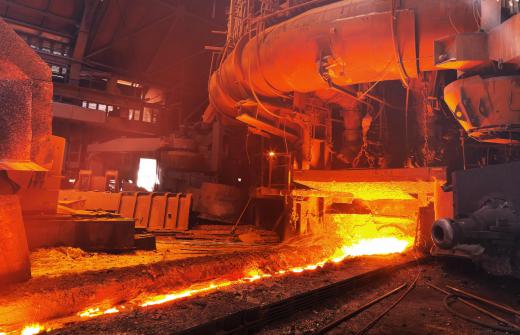At AboutMechanics, we're committed to delivering accurate, trustworthy information. Our expert-authored content is rigorously fact-checked and sourced from credible authorities. Discover how we uphold the highest standards in providing you with reliable knowledge.
What Are the Different Types of Lead Smelting Pots?
Lead smelting pots come in two basic types: the type that is held over a fire until the lead is melted, and the electric version that uses an electric heating coil to heat the lead smelting pots to melt the lead ingots inside. The electric version of lead smelting pots is the most common in use for home smelting projects, while industrial-grade smelting uses a mixture of both versions, albeit on a much larger scale. The smelting of lead can be done to produce a wide variety of components, from wheel balancing weights to fishing sinkers and muzzle loading shooting supplies.
Typically made of heavy cast iron, lead smelting pots can survive the repeated heating and cooling cycles associated with the smelting of lead. Lead is commonly purchased in large blocks requiring the use of lead smelting pots to melt it down to be poured into casting molds. The danger in smelting lead is in the toxic fumes that come off of the lead puddle. Protective suits, respirators and eye wear should always be worn regardless of the type of lead smelting pots being used. While the small, home-use lead smelting pots use regular household current to melt the lead, large industrial pots commonly use extremely high-voltage or carbon rods to create enough heat to melt large amounts of lead in a single pot.

The carbon arc lead smelting pots use carbon rods and electricity to create an arc very similar to a welding arc to create the heat required to melt large amounts of lead ingots. As the carbon arc burns under the large cast-iron cauldron, care must be taken not to burn through the cast iron. Experienced workers ensure that the heat is controlled and the lead is melted in the shortest time possible. Some older mills use a coal or oil fire to heat large cast iron smelting pots to temperature.

The most efficient type of smelting pot is the electric pot. These lead smelting pots use electricity to heat and melt the lead in a similar fashion to a small, home-use pot, but on a much larger scale. The elements can be placed under the pot or inside the pot, depending on design, and can reach the desired temperature in a very short time. Chemical additives are often used to prevent the lead from sticking to the pot, however, in an industrial-type cauldron, the lead is melted around the clock, thereby eliminating any problems from lead remaining in the pot.
AS FEATURED ON:
AS FEATURED ON:












Discussion Comments
@KoiwiGal - You don't have to buy a commercial mold to make those lead figures. There are instructions on how to make the molds online. I believe you can make them out of silicone.
You just need your own lead melting pot and to make sure that you have all the safety equipment. This is especially true if you are making your own molds as they will not be as safe as commercial molds. Be extremely careful.
That said, I remember seeing a set from the 60's that was supposed to be a toy soldier maker for kids. It was supposed to be for pre-teens, but it included real lead smelting equipment!
If the children of the 60's can do it, you can too, but just be careful. Molten lead is not a plaything and it can seriously harm you.
@indigomoth - I understand that it seems like a somewhat alien concept in this day and age where most metal things seem to come out of an industrial complex, but every home made object with metal components needs to have the metal components made somehow.
Actually I think one of the most popular things people make out of lead these days are little figures for games or collectibles.
The game collectible figures are often made out of lead and if you can get the mold to make them you can make a whole bunch much more cheaply than you could buy them from a store. Particularly if it is a larger or more elaborate figure.
Plus if you buy the lead mold with a group of fellow players you can split the cost between you.
This makes me think of a scene in the film "the World's Fastest Indian" where the main character is making his own components to go into his Indian motorcycle. He carefully makes his own molds and melts the metal in a melting pot before adding it to the molds.
To be honest, I'm not sure what kind of metal it was, but the scene seemed quite incredible to me. It's based on a true story, but I hadn't ever thought about someone making their own metal parts for a car or bike before.
I think lead would more often be used for things like fishing weights, but the idea of doing that for any reason seems so self sufficient, it really appeals to me.
Post your comments